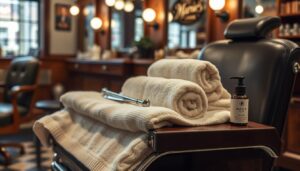As a man, the choice between a wet beard trim or a dry trim can significantly impact the health, appearance, and overall grooming of your facial hair. But have you ever wondered which method is truly superior? In this comprehensive article, we’ll delve into the intricate world of beard trimming, exploring the distinct advantages and disadvantages of each approach to help you make an informed decision.
Are you tired of uneven patches or split ends plaguing your beloved beard? Or perhaps you’ve found that your current trimming routine leaves your facial hair feeling coarse and unmanageable. Whatever your concerns may be, the answer could lie in the way you approach your beard maintenance.
Understanding the Basics of Beard Trimming
Maintaining a well-groomed beard requires regular trimming and shaping. Whether you prefer a wet or dry trim, it’s essential to understand the fundamentals of beard maintenance. Proper beard care starts with the right tools, including sharp scissors, a high-quality trimmer, and a trusty comb. Familiarizing yourself with these grooming tools can make the trimming process more efficient and effective.
Regularly trimming your beard helps keep it looking neat and tidy. The frequency of trimming can vary depending on your beard growth rate and personal preference, but most experts recommend a trim every 4-6 weeks. During the trimming process, pay attention to the length, shape, and density of your facial hair to achieve your desired look. Proper technique, such as cutting with the grain of the hair, can make a significant difference in the end result.
In addition to routine maintenance, it’s important to consider your beard type and how it responds to different trimming methods. Some individuals may find that a wet trim provides a more precise and controlled outcome, while others prefer the convenience and simplicity of a dry trim. Understanding the unique characteristics of your beard can help you determine the best approach to achieve the perfect look.
By mastering the basics of beard trimming, you can maintain a well-groomed and healthy-looking beard. Whether you’re a seasoned beard enthusiast or just starting your facial hair journey, incorporating these fundamental tips into your routine can help you achieve the perfect beard maintenance.
What Makes Wet Beard Trimming Different
When it comes to beard grooming, wet beard trimming offers a unique approach compared to the traditional dry trim. The key difference lies in the moisture content of the beard hair. During a wet beard trim, the facial hair is thoroughly dampened, either with water or a specialized beard wash, before the trimming process begins.
This added moisture softens the beard strands, making them more pliable and easier to control. Professionals in barbershop grooming often prefer the wet beard trim method as it allows for greater precision and a cleaner, more defined shape. The wet hair also tends to cling together, making it easier to identify stray or unruly hairs that need to be trimmed.
Additionally, the wet beard trim can help to minimize irritation and ingrown hairs, as the trimming is done on hair that is already softened and conditioned. This approach can be particularly beneficial for those with coarser or more unruly beard hair, as the moisture helps to tame and shape the facial hair more effectively.
However, the wet beard trim does require a bit more preparation and time, as the beard must be thoroughly dampened and allowed to absorb the moisture before the trimming can begin. Nevertheless, for those seeking a professional and polished look, the wet beard trim can be a game-changer in their barbershop grooming routine.
The Science Behind Dry Beard Trimming
When it comes to beard maintenance, the debate between wet and dry trimming often takes center stage. However, understanding the science behind dry beard trimming can shed light on its unique benefits. Unlike wet trimming, which requires the beard to be thoroughly dampened, dry trimming allows for better visibility of the beard’s natural shape and texture.
The key lies in the way hair behaves when it’s dry versus wet. Dry hair tends to be more coarse and stiff, making it easier to identify uneven lengths and straggly ends. This visibility enables a more precise trim, allowing you to blend different lengths seamlessly and maintain the desired beard shape. Additionally, dry trimming minimizes the chances of cutting too much, a common pitfall when working with wet hair that can become distorted and difficult to assess.

Grooming tools for beards, such as quality trimmers and scissors, are essential for achieving the best results with dry trimming. These specialized tools can navigate through the coarse, dry hair with ease, cutting it cleanly and evenly. By mastering the dry trimming technique, you can not only maintain your beard’s shape but also promote healthier growth and better overall appearance.
Ultimately, the science behind dry beard trimming highlights its advantages, including enhanced visibility, more precise control, and the ability to preserve the beard’s natural texture. For those seeking a smooth, well-groomed look, exploring the world of dry trimming can be a game-changer in their beard maintenance routine.
Professional Barber Insights on Wet vs Dry Trimming
When it comes to beard grooming, both wet and dry trimming have their unique advantages. To gain a deeper understanding, we reached out to seasoned barbers who shared their professional insights.
According to renowned barbershop grooming expert, Michael Johnson, wet trimming is often preferred for thicker, coarser beards. “The water helps soften the hairs and allows for a more precise cut,” he explains. “This method is great for achieving clean lines and sculpting the beard to the client’s desired shape.”
On the other hand, professional beard trimming specialist, Sarah Lee, notes that dry trimming can be advantageous for finer, straighter hair types. “Dry trimming gives you more control over the length and allows you to see the true shape of the beard,” she says. “This technique works well for clients who want a more natural, less structured look.”
Ultimately, the choice between wet or dry trimming often comes down to the individual’s beard type and personal preferences. As barber services have evolved, many skilled professionals are adept at adapting their techniques to meet the unique needs of each client.
Wet Beard Trim or Dry Trim: Making the Right Choice
When it comes to proper beard care and styling, the choice between a wet beard trim or a dry trim is an important one. Both methods have their own unique benefits, and the decision ultimately depends on your beard type, personal preference, and the desired look you’re aiming for.
For those with thicker, coarser beard hair, a wet trim can be the better option. The water helps soften the hair, making it easier to achieve a clean, even cut. This method is particularly useful for shaping and defining the beard’s edges, as the moistened hair is more pliable. On the other hand, dry trimming works better for individuals with finer, softer beard hair, as it allows for more precision and control during the styling process.
Ultimately, the choice between wet and dry beard trimming comes down to personal preference and the specific needs of your facial hair. Experimenting with both techniques can help you determine which method yields the best results for your men’s facial hair styling and proper beard care routine.
Common Mistakes to Avoid in Both Methods
Maintaining a well-groomed beard requires attention to detail, regardless of whether you opt for a wet or dry trimming approach. However, even the most seasoned beard enthusiasts can fall victim to common mistakes that can derail their beard maintenance routine. In this section, we’ll explore some of the most prevalent missteps to steer clear of when trimming your facial hair.
One of the most common errors is rushing the trimming process. Proper beard maintenance tips suggest taking your time and being deliberate with each snip. Rushing can lead to uneven cuts, missed patches, and an overall unpolished look. Patience is key when perfecting your beard maintenance routine.
Another pitfall to avoid is using dull or unsuitable grooming tools for beards. Investing in high-quality, sharp trimmers and scissors is essential for achieving clean, precise lines. Neglecting to properly maintain and sharpen your tools can result in ragged, jagged edges and an untidy appearance.
Lastly, many individuals overlook the importance of proper beard care practices, such as regular conditioning and moisturizing. Failing to nourish and hydrate the beard can lead to dry, brittle hairs that are more prone to split ends and unruliness. By incorporating these essential self-care steps, you can ensure your beard remains healthy, manageable, and visually appealing.

By being mindful of these common pitfalls and incorporating best practices for both wet and dry trimming methods, you can achieve a well-groomed, professional-looking beard that will turn heads for all the right reasons.
Tools and Products for Wet Beard Trimming
When it comes to wet beard trimming, having the right tools and products can make all the difference. Professional barbers and experienced home groomers alike rely on a carefully curated set of grooming tools to achieve that perfect, well-maintained beard. From specialized wet beard trimmers to high-quality beard oils, let’s explore the essential items for your wet beard trimming arsenal.
One of the most crucial tools for wet beard trimming is the wet beard trimmer. These trimmers are designed to seamlessly glide through damp facial hair, providing a clean, precise trim without pulling or tugging. Look for models with adjustable guards to ensure a customized length and shape for your unique beard style. Supplementing your trimmer, a pair of sharp barber scissors can help you fine-tune the edges and create crisp lines.
Beyond the tools, the products you use during the wet beard trimming process can make a significant difference in the final result. A high-quality beard oil or balm can help condition and soften your beard, making it more manageable for grooming. Invest in a beard comb or brush to ensure even distribution of the product and smooth out any stray hairs. With the right combination of wet beard trim tools and grooming products, you’ll be well on your way to a professional-level beard trim in the comfort of your own home.
Mastering the Dry Trimming Technique
For those who prefer a more precise and controlled approach to beard maintenance, the dry trimming technique is a must-master skill. This method allows you to achieve a well-groomed, tailored look for your facial hair without the added complexity of dealing with water and lather. Let’s dive into the steps to perfect your dry beard trimming techniques.
Begin by thoroughly brushing and combing your beard to ensure all the hairs are lying in the desired direction. This will help you identify any stray or unruly strands that need to be trimmed. Next, section your beard into manageable parts, working one area at a time. This will give you better visibility and control over the trimming process.
When trimming, start with the longest settings on your beard trimmer and gradually work your way down, removing small amounts of hair at a time. Pay close attention to the natural contours of your face, following the curves to create a polished, even appearance. Take your time and make small, precise snips – it’s better to remove less hair than to overdo it.
Finish by using a fine-toothed comb to lightly brush through your beard, ensuring all the hairs are neatly aligned. A quick pass with a pair of sharp scissors can also help clean up any stray ends. With a little practice, you’ll be able to master the dry trimming technique and maintain a well-groomed, sophisticated look for your men’s facial hair styling.
How Different Beard Types Respond to Each Method
When it comes to beard maintenance tips and proper beard care, the beard trimming method you choose can have a significant impact on the appearance and health of your facial hair. Men with varying beard types and textures may find that one trimming approach works better for their unique needs.
For those with coarse, thick beards, a wet trim may be the preferred option. The added moisture helps to soften the hair, making it easier to achieve a clean, even cut. On the other hand, men’s facial hair styling with a dry trim can be beneficial for individuals with finer, more delicate beard hair, as it allows for greater precision and control.
Curly or wavy beards may respond well to both wet and dry trimming, depending on individual preferences. The key is to experiment and find the technique that best tames and shapes your unique facial hair. Regularly incorporating proper beard care practices, such as using high-quality beard oils and balms, can also enhance the results of your chosen trimming method.
Remember, the goal of beard maintenance is to keep your facial hair looking its best. By understanding how your beard type reacts to wet and dry trimming, you can make an informed decision and achieve the desired look and feel for your beard.
Seasonal Considerations for Beard Trimming Methods
As the seasons change, so too should your approach to beard maintenance. Proper beard care requires adapting your trimming techniques and frequency to accommodate the shifts in weather, humidity, and lifestyle that come with each time of year. Understanding these seasonal factors can help you maintain a well-groomed, healthy beard year-round.
During the colder, drier months, your beard may become coarser and more prone to split ends. A wet beard trim can help hydrate the hair and skin, while a dry trim may be better for taming unruly flyaways. Conversely, in the warm, humid summer, a dry trim may be preferable to avoid excess moisture and maintain a crisp, clean look.
Barbershop grooming experts suggest evaluating your beard’s needs each season and adjusting your beard maintenance tips accordingly. This could mean more frequent trims in the summer to keep your facial hair in shape, or less aggressive trimming in the winter to preserve moisture and length. By staying in tune with your beard’s seasonal changes, you can ensure proper beard care and a consistently polished, confident look.
Whether you opt for a wet or dry beard trim, paying attention to the barbershop grooming techniques that work best for your facial hair throughout the year can make a significant difference in the health and appearance of your beard. With a little seasonal adjustment, you can maintain a well-groomed look that complements your style and lifestyle in every season.
Maintaining Your Trim: Aftercare Tips
Keeping your beard well-groomed and shaped doesn’t end with the initial trim. Regular maintenance is key to ensuring your facial hair remains neat, healthy, and styled to perfection. From daily cleansing routines to specialized products, this section covers all the essential aftercare tips to help you preserve your trimmed look.
Start your day with a gentle beard wash to remove any accumulated oil, dirt, or debris. Look for formulas infused with nourishing ingredients like aloe vera or jojoba oil to hydrate and condition the hair. Follow up with a high-quality beard oil or balm to lock in moisture and tame any unruly strands. Pair these with a versatile beard comb or brush to style your facial hair throughout the day.
To maintain the shape and length between trimming sessions, invest in a reliable pair of barber-quality scissors or clippers. Regularly trim any stray hairs or flyaways to keep your beard looking sharp and well-defined. Complement your at-home grooming routine with occasional visits to your local barbershop for a professional touch-up and expert advice on optimal beard care.






